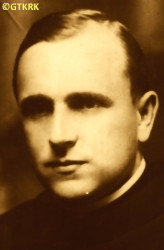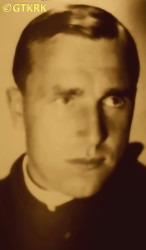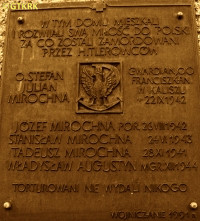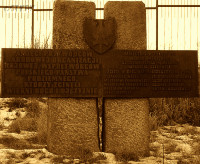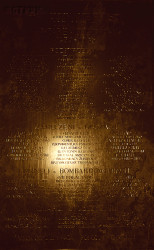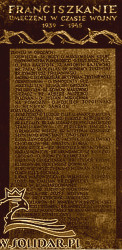Roman Catholic
St Sigismund parish
05-507 Słomczyn
85 Wiślana Str.
Konstancin deanery
Warsaw archdiocese, Poland
full list:
displayClick to display full list

searchClick to search full list by categories
wyświetlKliknij by wyświetlić pełną listę po polsku

szukajKliknij by przeszukać listę wg kategorii po polsku

Martyrology of the clergy — Poland
XX century (1914 – 1989)
personal data
surname
MIROCHNA
forename(s)
Steven Marian (pl. Stefan Marian)
religious forename(s)
Julian
function
religious cleric
creed
Latin (Roman Catholic) Church RCmore on
en.wikipedia.org
[access: 2014.09.21]
congregation
Order of Friars Minor Conventual OFMConvmore on
en.wikipedia.org
[access: 2013.05.19]
(i.e. Conventual Franciscans)
diocese / province
Immaculate Mary province OFMConvmore on
pl.wikipedia.org
[access: 2014.08.18]
st Anthony of Padua and bl. James Strzemię province OFMConvmore on
pl.wikipedia.org
[access: 2014.08.18]
date and place
of death
07.07.1942

KL Posenconcentration camp
today: Poznań, Poznań city pov., Greater Poland voiv., Poland
more on
en.wikipedia.org
[access: 2022.01.09]
alt. dates and places
of death
22.09.1942, 10.06.1943, 02‑03.11.1943
Poznańtoday: Poznań city pov., Greater Poland voiv., Poland
more on
en.wikipedia.org
[access: 2021.07.18]
details of death
After German and Russian invasion in 09.1939 of Poland and start of the World War II, after start of German occupation organiser — in Warthegau province, set up by the Germans in German occupied Greater Poland and directly incorporated into Germany — of Polish clandestine National Party (part of future Polish Clandestine State), nom‐de‐guerre „Kawka” („Jackdaw”).
From 01.1940 leadership member of National Unity Organisation OJN in Kalisz, from autumn of 1940 part of National Fighting Organization NOB, lead from Poznań — among others as a director of clandestine Social Care Department.
Listened to Western radio–broadcasts (possession of radio receivers was made by Germans illegal) and co–edited clandestine „National Unity” magazine.
In 12.1940 arrests by Germans commenced — initially in Poznań, from 02.1941 in Kalisz.
Germans tracked him down as well.
In 02.1941 managed however to escape — in woman's clothing — to the German‐run Germ. Generalgouvernement (Eng. General Governorate).
Went into hiding in Warsaw under Anthony Lis name.
Wanted by the Germans — for his address a bounty of 25,000 Deutsch marks was set aside — and as a result of German provocation was arrested in Warsaw on 21.11.1941.
Held in Pawiak prison in Warsaw and next in 01.1942 moved — as a „citizen” of German state — back to Warthegau province and held in KL Posen (Fort VII) concentration camp.
In Gestapo jail at Młyńska Str. in Poznań intensively interrogated and tortured (had arms broken).
Beaten by dogs let loose.
While in hospital — to be cured prior to next set of interrogations — held chained to the wall.
Did not reveal anything.
In the evening of 07.07.1942, at 20:00, driven out of KL Posen and during the night murdered together with c. 20 other Polish clandestine resistance activists, in a „forest n. Poznań”.
alt. details of death
According to some account hunged.
cause of death
murder
perpetrators
Germans
sites and events
Murder 07.07.1942 KL PosenClick to display the description, SPL PosenClick to display the description, UH PosenClick to display the description, KL PosenClick to display the description, PawiakClick to display the description, GeneralgouvernementClick to display the description, Reichsgau WarthelandClick to display the description, 03.1941 arrests (Kalisz)Click to display the description, Ribbentrop‐MolotovClick to display the description, Pius XI's encyclicalsClick to display the description
date and place
of birth
31.08.1903

Bochniatoday: Bochnia urban gm., Bochnia pov., Lesser Poland voiv., Poland
more on
en.wikipedia.org
[access: 2021.04.01]
religious vows
26.10.1919 (temporary)
presbyter (holy orders)
ordination
06.06.1926

Krakówtoday: Kraków city pov., Lesser Poland voiv., Poland
more on
en.wikipedia.org
[access: 2021.06.07]
positions held
1935 – 1940
guardian — Kalisztoday: Kalisz city pov., Greater Poland voiv., Poland
more on
en.wikipedia.org
[access: 2020.12.16] ⋄ St Stanislav the Bishop and Martyr monastery, Conventual Franciscans OFMConv
1934 – 1935
vicar — Łagiewnikitoday: neighborhood in Łódź city, Łódź city pov., Łódź voiv., Poland
more on
en.wikipedia.org
[access: 2021.07.18] ⋄ St Anthony of Padua and St John the Baptist monastery, Conventual Franciscans OFMConv ⋄ St Anthony of Padua RC parish ⋄ Zgierztoday: Zgierz urban gm., Zgierz pov., Łódź voiv., Poland
more on
en.wikipedia.org
[access: 2021.12.18] RC deanery — also: socius to the novices' mastrer and retreatist
1930 – c. 1933
vicar — Gnieznotoday: Gniezno urban gm., Gniezno pov., Greater Poland voiv., Poland
more on
en.wikipedia.org
[access: 2021.12.18] ⋄ Assumption of the Blessed Virgin Mary monastery, Conventual Franciscans OFMConv ⋄ Assumption of the Blessed Virgin Mary RC parish ⋄ Gniezno Holy Trinitydeanery name
today: Gniezno urban gm., Gniezno pov., Greater Poland voiv., Poland
more on
en.wikipedia.org
[access: 2021.12.18] RC deanery — also: monastery vicar, director of the Marian Choir and retreatist
1929 – c. 1930
friar — Łagiewnikitoday: neighborhood in Łódź city, Łódź city pov., Łódź voiv., Poland
more on
en.wikipedia.org
[access: 2021.07.18] ⋄ St Anthony of Padua and St John the Baptist monastery, Conventual Franciscans OFMConv — prefect of the parish school and retreatist
1928 – 1929
friar — Jasłotoday: Jasło urban gm., Jasło pov., Subcarpathia voiv., Poland
more on
en.wikipedia.org
[access: 2021.10.09] ⋄ St Anthony of Padua monastery, Conventual Franciscans OFMConv — retreat preacher and missionary
1926 – 1928
friar — Horyniectoday: Horyniec Zdrój, Horyniec‐Zdrój gm., Lubaczów pov., Subcarpathia voiv., Poland
more on
en.wikipedia.org
[access: 2020.11.24] ⋄ Immaculate Conception of the Blessed Virgin Mary monastery, Conventual Franciscans OFMConv — retreat preacher and missionary
1920 – 1926
student — Krakówtoday: Kraków city pov., Lesser Poland voiv., Poland
more on
en.wikipedia.org
[access: 2021.06.07] ⋄ Philosophical and Theological Studies, St Francis of Assisi monastery, Conventual Franciscans OFMConv
1919 – 1920
friar — Lvivtoday: Lviv urban hrom., Lviv rai., Lviv obl., Ukraine
more on
en.wikipedia.org
[access: 2022.01.16] ⋄ Immaculate Conception of the Blessed Virgin Mary monastery, Conventual Franciscans OFMConv — student of Minor Theological Seminary (gimnasium)
20.10.1918 – 26.10.1919
novitiate — Łagiewnikitoday: neighborhood in Łódź city, Łódź city pov., Łódź voiv., Poland
more on
en.wikipedia.org
[access: 2021.07.18] ⋄ St Anthony of Padua and St John the Baptist monastery, Conventual Franciscans OFMConv
19.08.1918
accession — Lvivtoday: Lviv urban hrom., Lviv rai., Lviv obl., Ukraine
more on
en.wikipedia.org
[access: 2022.01.16] ⋄ Immaculate Conception of the Blessed Virgin Mary monastery, Conventual Franciscans OFMConv
others related
in death
BARTCZAKClick to display biography Vladislav (Bro. Theodore), BINIEWICZClick to display biography John, GOŁĘBIOWSKIClick to display biography Joseph, GORAJECKIClick to display biography Michael, HERBICHClick to display biography Henry Joseph Adam, ŁOPUSZYŃSKIClick to display biography Casimir Roman, MAKOWSKIClick to display biography Francis (Bro. Simon), MOŻEJKOClick to display biography Joseph (Bro. Albert Mary), NIEWĘGŁOWSKIClick to display biography Stanislav, NOWACKIClick to display biography Octavian Mieczyslav Boleslav, ŚWIEŻEWSKIClick to display biography Casimir Alexander, ZABOROWICZClick to display biography Stanislav, ZAWADZKIClick to display biography Joseph
sites and events
descriptions
Murder 07.07.1942 KL Posen: On 07.07.1942, at 20:00 in the evening, names of c. 20 Polish clandestine resistance leaders were called in from the cells of KL Posen concentration camp. All in handcuffs were driven out on the truck in unknown direction. Next day their clothes were returned to the prison warehouse. Among them was Graf Adolf Bniński, Catholic Action chairman and Chief Delegate of the Polish Government (then in exile) for Polish territories directly in 1939 incorporated into Germany, representing clandestine resistance Armed Struggle Union ZWZ (part of Polish Clandestine State), grouping such organisation as „Ojczyzna” („Homeland”), National Fighting Organisation NOB, Poznań Armed Organisation POZ, Greater Poland Military Organisation (WOW), Clandestine Polish Military Organisation (TPOW), territorially operation in Poznań district (roughly pre‐war Poznań voivodeship). Also the name of Fr Stephen Maria Mirochna was called in. The command of Polish Clandestine State in Greater Poland Germans smashed in 09‐12.1941. The arrested were held in KL Posen (Fort VII) concentration camp in Poznań. There as direct result of German brutality few of the prisoners perished. At least one more was murdered during interrogations and tortures in Soldiers House and Młyńska Str. jail in Poznań. The place of death of the others driven out of KL Posen remain unknown. One of the Germans claimed that „they had died bravely, but had had the death worse than Christians during Nero time”. Thus one the version — unconfirmed — states that they were given to wild animals in Poznań animal park ZOO. Most likely they all were executed — without a trial, for German summary kangaroo courts started to function in Greater Poland from 08.1942 — in Stęszew forests, and in 1944 Germans dug out their bodies and burnt them. (more on: poznan.ipn.gov.plClick to attempt to display webpage
[access: 2019.04.16])
SPL Posen: Germ. Staatpolizeileitstelle Posen (Eng. Poznań State Police Command Centre), founded on 07.11.1939 — in the Soldier's House at 1 Niezłomnych Str. — by the Germ. Geheime Staatspolizei (Eng. Secret State Police), i.e. Gestapo, after taking over the building from the Germ. Einsatzgruppe VI der Sicherheitspolizei und des SD (Eng. Task Group VI of the Security Police and SD), which had its HQ there from 12.09.1939, the day the Germans captured Poznań. The Centre performed a superior function to Gestapo offices in the entire Germ. Reichsgau Wartheland (Eng. Wartheland Reich District). It housed the Germ. Hausgefängnis (Eng. house arrest). In the basement, on the bare floor, 40‐120 prisoners were held in shackles. In the rooms on the floors, long interrogations were conducted, during which confessions of guilt and signing of protocols were forced by torture. The Germ. Polizeistandgericht (Eng. police summary court) operated there as well, with unlimited competences — the sentences issued were not subject to appeal. Those convicted of „lesser crimes” were transported to the KL Posen concentration camp, and then to other concentration camps. Those sentenced to death were taken to the UH Posen prison on Młyńska Str., where the sentences were carried out. On 20.01.1945, in the face of the Russian offensive, the Germans began the evacuation of the Centre, and on 02.02.1945 they partially blew up the building. (more on: pl.wikipedia.orgClick to attempt to display webpage
[access: 2015.09.30])
UH Posen: Germ. Untersuchungshaftanstalt Posen (Eng. Poznań Detention Centre), run by the Germ. Geheime Staatspolizei (Eng. Secret State Police), i.e. Gestapo, at 1 Młyńska Str. in Poznań. Death sentences by guillotine and hanging were also carried out there — in total, during World War II, the Germans are said to have murdered at least 1,639 people there (1,532 men, 93 women and 14 children — people under the age of 18), including c. 1,400 people who were probably killed by guillotine. Convicts in custody were greeted: Germ. „Wir werden auch mit dir fertig sein — Kopf herunter” (Eng. „We will finish you too — keep your head down”). Sentences were usually carried out on Tuesdays and Fridays, around on 06:00. According to the testimony of one of the German executioners: „Two assistants took the condemned by the arms and led him to a bench, where they laid him face down. The head stuck out above the bathtub. A special board pressed the condemned man's neck. At the prosecutor's call, the executioner dropped a knife weighing 2–3 hundredweight. The severed head fell into the bathtub”. (more on: pl.wikipedia.orgClick to attempt to display webpage
[access: 2013.10.05])
KL Posen: German Posen — Fort VII — camp founded in c. 10.10.1939 in Poznań till mid of 11.1939 operated formally as Germ. Konzentrationslager (Eng. concentration camp) KL Posen, and this term is used throughout the White Book, also later periods. It was first such a concentration camp set up by the Germans on Polish territory — in case of Greater Poland (Wielkopolska) directly incorporated into German Reich. In 10.1939 in KL Posen for the first time Germans used gas to murder civilian population, in particular patients of local psychiatric hospitals. From 11.1939 the camp operated as German political police Gestapo prison and transit camp (Germ. Übergangslager), prior to sending off to concentration camps, such as KL Dachau or KL Auschwitz. In 28.05.1941 the camp was rebranded as police jail and slave labour corrective camp (Germ. Arbeitserziehungslager). At its peak up to 7‐9 executions were carried in the camp per day, there were mass hangings of the prisoners and some of them were led out to be murdered elsewhere, outside of the camp. Altogether in KL Posen Germans exterminated approx. 20,000 inhabitants of Greater Poland (Wielkopolska) region, including many representatives of Polish intelligentsia, patients and staff of psychiatric hospitals and dozen or so Polish priests. Hundreds of priests were held there temporarily prior to transport to other concentration camps, mainly KL Dachau. From 03.1943 the camp had been transformed into an industrial complex (from 25.04.1944 — Telefunken factory manufacturing radios for submarines and aircrafts). (more on: www.wmn.poznan.plClick to attempt to display webpage
[access: 2019.02.02], en.wikipedia.orgClick to attempt to display webpage
[access: 2013.12.27])
Pawiak: Investigative prison in Warsaw, built by the Russian occupiers of Poland in 1830‐1835. During the Poland partition's period, a Russian investigative prison, both criminal and political. During World War II and the German occupation, the largest German prison in the Germ. Generalgouvernement (Eng. General Governorate). Initially, it was subordinate to the Justice Department of the General Governorate, and from 03.1940 Germ. Sicherheitspolizei und des Sicherheitsdienst (Eng. Security Police and Security Service) of the Warsaw District — in particular the German Secret Political Police Gestapo. c. 3,000 prisoners were kept in Pawiak permanently, of which about 2,200 in the men's unit and c. 800 in the women's unit (the so‐called Serbia) — with a „capacity” of c. 1,000 prisoners. In total, in the years 1939‐1944, c. 100,000 Poles passed through the prison, of which c. 37,000 were murdered in executions — from 10.1943 Pawiak prisoners were murdered in open executions on the streets of Warsaw (sometimes several times a day) — during interrogations, in cells or in a prison „hospital”, and c. 60,000 were taken in 95 transports to concentration camps (mainly KL Auischwitz), other places of isolation or to forced labor. The prison Germans demolished during the Warsaw Uprising in 08‐10.1944. (more on: en.wikipedia.orgClick to attempt to display webpage
[access: 2022.08.17])
Generalgouvernement: After the Polish defeat in the 09.1939 campaign, which was the result of the Ribbentrop‐Molotov Pact and constituted the first stage of World War II, and the beginning of German occupation in part of Poland (in the other, eastern part of Poland, the Russian occupation began), the Germans divided the occupied Polish territory into five main regions. In two of them new German provinces were created, two other were incorporated into other provinces. However, the fifth part was treated separately, and in a political sense it was supposed to recreate the German idea from 1915 (during World War I, after the defeat of the Russians in the Battle of Gorlice in 05.1915) of creating a Polish enclave within Germany. Illegal in the sense of international law, i.e. Hague Convention, and public law, managed by the Germans according to separate laws — especially established for the Polish Germ. Untermenschen (Eng. subhumans) — till the Russian offensive in 1945 it constituted part of the Germ. Großdeutschland (Eng. Greater Germany). Till 31.07.1940 formally called Germ. Generalgouvernement für die besetzten polnischen Gebiete (Eng. General Government for the occupied Polish lands) — later simply Germ. Generalgouvernement (Eng. General Governorate), as in the years 1915‐1918. From 07.1941, i.e. after the German attack on 22.06.1941 against the erstwhile ally, the Russians, it also included the Galicia district, i.e. the Polish pre‐war south‐eastern voivodeships. A special criminal law was enacted and applied to Poles and Jews, allowing for the arbitrary administration of the death penalty regardless of the age of the „perpetrator”, and sanctioning the use of collective responsibility. After the end of the military conflict of the World War UU, the government of the Germ. Generalgouvernement was recognized as a criminal organization, and its leader, governor Hans Frank, guilty of war crimes and crimes against humanity and executed. (more on: en.wikipedia.orgClick to attempt to display webpage
[access: 2024.12.13])
Reichsgau Wartheland: After the Polish defeat in the 09.1939 campaign, which was the result of the Ribbentrop‐Molotov Pact and constituted the first stage of World War II, and the beginning of German occupation in part of Poland (in the other, eastern part of Poland, the Russian occupation began), the Germans divided the occupied Polish territory into five main regions (and a few smaller). The largest one was transformed into Germ. Generalgouvernement (Eng. General Governorate), intended exclusively for Poles and Jews and constituting part of the so‐called Germ. Großdeutschland (Eng. Greater Germany). Two were added to existing German provinces. From two other separate new provinces were created. Greater Poland region was one of them, incorporated into Germany on 08.10.1939, by decree of the German leader Adolf Hitler (formally came into force on 26.10.1939), and on 24.01.1940 transformed into the Germ. Reichsgau Wartheland province, in which the law of the German state was to apply. The main axis of the policy of the new province, the territory of which the Germans recognized as the Germ. „Ursprünglich Deutsche” (Eng. „natively German”), despite the fact that 90% of its inhabitants were Poles, was Germ. „Entpolonisierung” (Eng. „Depolonisation”), i.e. forced Germanization. C. 100,000 Poles were murdered as part of the Germ. „Intelligenzaktion”, i.e. extermination of Polish intelligentsia and ruling classes. C. 630,000 were forcibly resettled to the Germ. Generalgouvernement, and their place taken by the Germans brought from other areas occupied by Germany (e.g. the Baltic countries, Bessarabia, Bukovina, etc.). Poles were forced to sign the German nationality list, the Germ. Deutsche Volksliste DVL. As part of the policy of „Ohne Gott, ohne Religion, ohne Priesters und Sakramenten” (Eng. „No God, no religion, no priest or sacrament”) most Catholic priests were arrested and sent to concentration camps. All schools teaching in Polish, Polish libraries, theaters and museums were closed. Polish landed estates confiscated. To further reduce the number of the Polish population, Poles were sent to forced labor deep inside Germany, and the legal age of marriage for Poles was increased (25 for women, 28 for men). The German state office, Germ. Rasse‐ und Siedlungshauptamt (Eng. Main Office of Race and Settlement) RuSHA, under the majesty of German law, abducted several thousand children who met specific racial criteria from Polish families and subjected them to forced Germanization, handing them over to German families. After the end of hostilities of World War II, the overseer of this province, the Germ. Reichsstatthalter (Eng. Reich Governor) and the Germ. Gauleiter (Eng. district head) of the German National Socialist Party, Arthur Karl Greiser, was executed. (more on: en.wikipedia.orgClick to attempt to display webpage
[access: 2024.06.21])
03.1941 arrests (Kalisz): In 02‐03.1941 in Kalisz and vicinity Germans conducted mass arrests of Poles (c. 400 people), under the pretext of a beating of German policeman local Polish population was blamed of. Among the apprehended were people (c. 85) suspected of participation in Polish clandestine resistance National Unity Organisation OJN, belonging to National Fighting Organization NOB (part of Polish Clandestine State). Among those arrested on 04‐06.03.1941 were at least 9 priests and 4 religious friars and many of their parishioners. At least two of them were subsequently tried by German Sondergericht (Eng. special court) and sentenced to death. 204 prisoners among whom 65 were linked to OJN activities were on 02.05.1941 transported to KL Auschwitz concentration camp. Only 34 survived. All the arrested priests and friars perished. In retribution Germans prohibited activities of Conventual Franciscans in Warthegau province (Greater Poland). (more on: pl.wikipedia.orgClick to attempt to display webpage
[access: 2016.03.14], www.info.kalisz.plClick to attempt to display webpage
[access: 2016.03.14])
Ribbentrop‐Molotov: Genocidal Russian‐German alliance pact between Russian leader Joseph Stalin and German leader Adolf Hitler signed on 23.08.1939 in Moscow by respective foreign ministers, Mr. Vyacheslav Molotov for Russia and Joachim von Ribbentrop for Germany. The pact sanctioned and was the direct cause of joint Russian and German invasion of Poland and the outbreak of the World War II in 09.1939. In a political sense, the pact was an attempt to restore the status quo ante before 1914, with one exception, namely the „commercial” exchange of the so‐called „Kingdom of Poland”, which in 1914 was part of the Russian Empire, fore Eastern Galicia (today's western Ukraine), in 1914 belonging to the Austro‐Hungarian Empire. Galicia, including Lviv, was to be taken over by the Russians, the „Kingdom of Poland” — under the name of the General Governorate — Germany. The resultant „war was one of the greatest calamities and dramas of humanity in history, for two atheistic and anti‐Christian ideologies — national and international socialism — rejected God and His fifth Decalogue commandment: Thou shall not kill!” (Abp Stanislav Gądecki, 01.09.2019). The decisions taken — backed up by the betrayal of the formal allies of Poland, France and Germany, which on 12.09.1939, at a joint conference in Abbeville, decided not to provide aid to attacked Poland and not to take military action against Germany (a clear breach of treaty obligations with Poland) — were on 28.09.1939 slightly altered and made more precise when a treaty on „German‐Russian boundaries and friendship” was agreed by the same murderous signatories. One of its findings was establishment of spheres of influence in Central and Eastern Europe and in consequence IV partition of Poland. In one of its secret annexes agreed, that: „the Signatories will not tolerate on its respective territories any Polish propaganda that affects the territory of the other Side. On their respective territories they will suppress all such propaganda and inform each other of the measures taken to accomplish it”. The agreements resulted in a series of meeting between two genocidal organization representing both sides — German Gestapo and Russian NKVD when coordination of efforts to exterminate Polish intelligentsia and Polish leading classes (in Germany called «Intelligenzaktion», in Russia took the form of Katyń massacres) where discussed. Resulted in deaths of hundreds of thousands of Polish intelligentsia, including thousands of priests presented here, and tens of millions of ordinary people,. The results of this Russian‐German pact lasted till 1989 and are still in evidence even today. (more on: en.wikipedia.orgClick to attempt to display webpage
[access: 2015.09.30])
Pius XI's encyclicals: Facing the creation of two totalitarian systems in Europe, which seemed to compete with each other, though there were more similarities than contradictions between them, Pope Pius XI issued in 03.1937 (within 5 days) two encyclicals. In the „Mit brennender Sorge” (Eng. „With Burning Concern”) published on 14.03.1938, condemned the national socialism prevailing in Germany. The Pope wrote: „Whoever, following the old Germanic‐pre‐Christian beliefs, puts various impersonal fate in the place of a personal God, denies the wisdom of God and Providence […], whoever exalts earthly values: race or nation, or state, or state system, representatives of state power or other fundamental values of human society, […] and makes them the highest standard of all values, including religious ones, and idolizes them, this one […] is far from true faith in God and from a worldview corresponding to such faith”. On 19.03.1937, published „Divini Redemptoris” (Eng. „Divine Redeemer”), in which criticized Russian communism, dialectical materialism and the class struggle theory. The Pope wrote: „Communism deprives man of freedom, and therefore the spiritual basis of all life norms. It deprives the human person of all his dignity and any moral support with which he could resist the onslaught of blind passions […] This is the new gospel that Bolshevik and godless communism preaches as a message of salvation and redemption of humanity”… Pius XI demanded that the established human law be subjected to the natural law of God , recommended the implementation of the ideal of a Christian state and society, and called on Catholics to resist. Two years later, National Socialist Germany and Communist Russia came together and started World War II. (more on: www.vatican.vaClick to attempt to display webpage
[access: 2023.05.28], www.vatican.vaClick to attempt to display webpage
[access: 2023.05.28])
sources
personal:
www.franciszkanie-warszawa.plClick to attempt to display webpage
[access: 2021.12.19], www.archiwum.kalisz.plClick to attempt to display webpage
[access: 2019.04.16], www.panstwo.netClick to attempt to display webpage
[access: 2019.04.16], prawy.plClick to attempt to display webpage
[access: 2019.04.16], poznan.ipn.gov.plClick to attempt to display webpage
[access: 2019.04.16]
bibliographical:
„Martyrology of the Polish Roman Catholic clergy under nazi occupation in 1939‐1945”, Victor Jacewicz, John Woś, vol. I‐V, Warsaw Theological Academy, 1977‐1981
„Patriot till the end”, Mr Raphael Sierchuła, „New State”, 11/2018
„Biographical–bibliographical dictionary of Polish Conventual Franciscan Fathers murdered and tragically dead in 1939‐1945”, Lukas Janecki, Franciscan Fathers’ Publishing House, Niepokalanów, 2016
original images:
www.franciszkanie-warszawa.plClick to attempt to display webpage
[access: 2021.12.19], www.miejscapamiecinarodowej.plClick to attempt to display webpage
[access: 2019.04.16], pl.wikipedia.orgClick to attempt to display webpage
[access: 2014.01.16], www.sowiniec.com.plClick to attempt to display webpage
[access: 2014.07.11]
LETTER to CUSTODIAN/ADMINISTRATOR
If you have an Email client on your communicator/computer — such as Mozilla Thunderbird, Windows Mail or Microsoft Outlook, described at WikipediaPatrz:
en.wikipedia.org, among others — try the link below, please:
LETTER to CUSTODIAN/ADMINISTRATORClick and try to call your own Email client
If however you do not run such a client or the above link is not active please send an email to the Custodian/Administrator using your account — in your customary email/correspondence engine — at the following address:

giving the following as the subject:
MARTYROLOGY: MIROCHNA Steven Marian
To return to the biography press below:
 Click to return to biography
Click to return to biography








